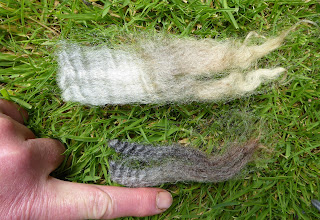"Hmmm. The Impatiens balsamina seedlings are still damp but it's done them no good, they've all flopped anyway. Looks pretty terminal to me. I think their stalks grew too leggy by the window indoors to cope without a greenhouse. Even in this warm weather." I slid my glasses back up my sweaty nose to focus on the other trays. "No sign at all of the woad germinating. Possibly two miniscule weld plants are sprouting. Or maybe they're weeds."
"Ooo, you've got more than half a dozen Japanese Indigo coming up. That's good isn't it?"
"Not sure where I can grow Japanese Indigo plants if they do survive. When I tried to dig a hole in the garden to put that clematis in, I found a solid foot of builders' rubble two inches below ground. Not exactly a cool moist root run."
Elinor sighed. "The very thought is dehydrating. Get the kettle on, Beaut."
"Fancy a walk?" Elinor finished the Diabolical Sudoku and put her newspaper down.
"Suppose the dog needs an airing."
"You could do with some sunshine too, you mouldy old Grouch Bag. Dig your sandals out and let's go and enjoy the lambs in the fields and Spring just bursting up everywhere."
"I'd gladly wear the usual woolly jumper, hat, scarf, coat and bring an umbrella if we didn't have Lockdown. Spring ought to mean going to Wonderwool, shopping for fibre, meeting all my friends and eating cake and I'm just sad that none of that will be happening."
"Chocolate cake! Crack on with the baking Beaut, it's practically Easter." Elinor dumped a bag of shopping on the kitchen floor. "Got all the ingredients for you. Did I mention I've gone Vegan?"
Including avocados in both the sponge and the icing had strangely contrary effects. Far from being cooked in 25 minutes, the cake mix stayed gloopy in the middle for over an hour, by which time the frosting seemed to have solidified. Luckily, it softened up again in an improvised Bain Marie over the broccoli soup.
I yelped as the tea towel slipped off a hot cake tin when at last I could turn the sponges out.
"Couldn't you just have bought some custard creams, Elinor? They're vegan."
"Never." She looked at me severely over her specs. "The palm oil in them is not sustainably sourced."
"Heaven forbid you should eat an unethical biscuit."
"No animals were harmed in the making of this chocolate cake." said my companion with great satisfaction.
Sucking the burn on my thumb, I reflected that this was not entirely true.
Happy Easter Everyone













































